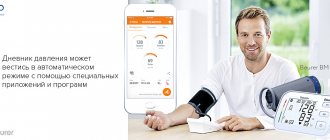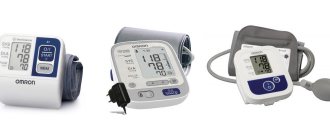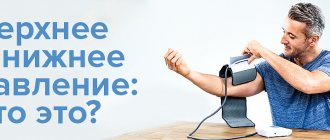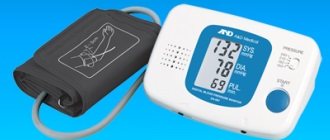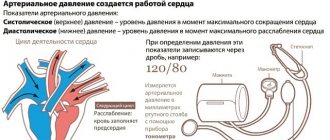What is blood pressure (BP)?
This is the pressure with which blood presses against the wall of the arterial vessel. It consists of 2 numbers: the upper (systolic) is the pressure on the vessel wall at the moment when the heart contracts, and the lower (diastolic) when the aortic valve is closed and the heart relaxes and rests. Systolic pressure is determined by cardiac output, and diastolic pressure depends on how spasmodic or dilated the vessels are, that is, on their tone. Blood pressure up to 140/90 mmHg is considered normal. Anything higher is arterial hypertension, the most common complication of which is stroke or heart attack.
You decided to measure your blood pressure, but it turned out to be elevated. You immediately start taking pills, calling your children or calling an ambulance.
In fact, it may be normal, you just made a mistake when measuring.
First rule . Sit down, lean back in your chair, relax, place your arm bent at the elbow on the armrest or table so that it is at heart level, and place the cuff 2-3 cm above the bend. Tension and anxiety increases blood pressure by 10 mmHg. Under no circumstances should you measure blood pressure while standing or holding your arm suspended.
Secondly , it is not recommended to measure blood pressure through clothing, especially thick clothing. The cuff first compresses the clothing and only then the blood vessels, therefore blood pressure rises. Because of this, its maximum increase can be up to 40 mmHg. The thicker the clothing, the higher the blood pressure.
The third mistake when determining blood pressure is incorrect posture. You sat down, crossed your legs, it’s comfortable for you, but the vessels of the lower extremities are compressed, they narrowed, blood pressure increased by another 8-10 mmHg.
If you made all of the above mistakes, then in total this will add 50-60 mmHg to your true pressure. You think that you have high blood pressure, you are nervous, you take medications that you do not need at the moment, but it is actually normal.
Repeated pressure measurements
If you take measurements several times in a row, the tonometer will show different pressures. This is due to the fact that after the first check, the vessel walls compressed by the device did not have time to recover, and blood flow is still difficult. In this regard, it is recommended to re-measure only after 3-5 minutes.
“It is advisable to measure the pressure on both arms. First on one, then on the other. Then the indicator will be more accurate. It is recommended to measure the pressure three times, and the highest value is considered the true pressure,” says Doctor of Medical Sciences, Professor of the Russian National Research Medical University named after. N.I. Pirogova, therapist Alexander Karabinenko .
How to measure blood pressure correctly?
Do not forget that the pressure must be measured silently , without talking, while in a calm state, since when talking, the muscles tense, their tone increases and blood pressure also becomes higher by 15 mmHg.
It is impossible to measure pressure with a full bladder, since blood pressure rises when holding urine. After going to the toilet - minus 15 mmHg. We also need to remember that when we are in a cold room, we add BP + 20 mmHg to the normal numbers.
Therefore, before you are going to measure your blood pressure, so that the numbers are objective, just go to the toilet, sit in a warm room, relax, lower your legs, roll up your sleeve and then your blood pressure will not be higher than 140/90 mmHg.
Taking care of your health,
Feature of the tonometer
Tonometers for home use are mechanical, mercury or electronic. “There are many cases when the tonometer shows the pressure incorrectly. Firstly, it could be an incorrectly applied cuff or insufficient air inflation. If it is a membrane-dial tonometer, then the needle may be faulty; if it is a mercury one, then the mercury reservoir is not filled properly. Electronic tonometers generally show pressure with an error of plus or minus 15 points of mercury,” says Karabinenko.
Article on the topic
Arithmetic for hypertensive patients. How to correctly calculate the appropriate pressure
Replacing batteries and caring for the tonometer
Often problems with measuring pressure arise due to discharged batteries. Before using the device, you should check the batteries and replace them if necessary. Many blood pressure monitors indicate on the screen that the batteries are low using a special icon. The same applies to models with a battery that needs to be recharged in a timely manner.
If the indicator indicates low batteries, you must reset the result, turn off the device and replace the batteries. Only then should the measurements be repeated.
Another cause of malfunctions is improper care of the device and violation of the rules for storing it. The tonometer needs to be cleaned from time to time using a slightly moistened cloth. Do not treat the device with cleaning agents or solvents.
Neither the device nor the cuff should be immersed in water, as this will cause damage. You should also not place heavy objects on them, and strong bends in the hoses are not allowed. Before long-term storage, remove the batteries. Do not store the device near a heat source, for example, near a battery.
Failure to follow instructions
Incorrect readings can be obtained if you measure pressure without following the rules listed in the tonometer user manual. It is important to put the cuff on correctly; it should be located 1-2 cm above the elbow and fit snugly to the skin. If this is not done, it will produce either a measurement error or incorrect results. It must also be the right size, otherwise if the cuff is small, the pressure measurement result will be overestimated, and if the size is too large, it will be underestimated.
The indicators will also be affected by the position in which the person measures the pressure and his condition. During measurements, it is better to remain silent and try not to move. The arm on which the cuff is located should rest on the armrest. If it hangs along your body or you are forced to hold it, your blood pressure reading may become several points higher.
“It is correct to measure pressure while lying or sitting, but completely relaxed, without putting one leg on top of the other. If a person sits cross-legged, the pressure increases by 10-15 millimeters of mercury,” says Karabinenko.
Interval between procedures
The question of how often you can measure blood pressure with an electronic tonometer is very relevant. Medical professionals unanimously believe that the frequency of monitoring depends on certain factors. People in excellent shape can take measurements from time to time, but those who suffer from cardiac diseases should approach the procedure responsibly and monitor their blood pressure more often. In old age, frequent measurements are contraindicated. This is due to the extreme fragility of blood vessels. To determine how often you can measure your blood pressure with an electronic tonometer, you need to evaluate the following factors:
- general well-being of a person;
- age;
- presence of concomitant diseases;
- features of previously suffered diseases;
- a type of tonometer.
All people, without exception, should monitor their blood pressure, only the frequency of measurements in each case may differ significantly. For example, it is enough for a healthy person to take measurements once every few months. And for those who suffer from cardiac ailments, blood pressure should be measured daily.
Is it harmful to measure blood pressure frequently? Is there a risk?
Many patients at a doctor's appointment are interested in whether it is harmful to frequently measure blood pressure with an electronic tonometer. And also how often it is better to do this. Experts say that frequent blood pressure measurements do not cause physical harm to a person, but can provoke a neurosis of obsessive blood pressure measurement. This mental disorder is difficult to cure, so it is not recommended to use the device unless necessary.
When asked about how many times to measure blood pressure with an electronic tonometer, experts have the following opinion:
- if you feel consistently good at home, blood pressure should be monitored no more than twice a day;
- Measurements should not be taken when the body is at its peak of activity.
If a person often measures his blood pressure with an electronic tonometer throughout the day, is this harmful? The question is rhetorical. This, first of all, indicates the presence of a psychological problem and can confuse not only the patient, but also the doctor.
Impaired cuff filling
Impaired air filling of the cuff can be expressed in different ways. For example, if the blood pressure monitor does not inflate the cuff or deflates quickly, the cause may be:
- Damage to the cuff - there is a special chamber inside it that can wear out or become damaged. In this case, it begins to deflate;
- Contamination or failure of the valve responsible for retaining air in the cuff;
- Broken tubes or connector at the cuff connection point.
When the tonometer does not pump air, most often the problem lies in the integrity of the parts. Finding the specific cause of a malfunction and eliminating it yourself is extremely difficult; it is better to entrust the solution to this issue to professionals.
The opposite situation is that the tonometer does not bleed air when measuring pressure. The first thing to do in such a situation is to check the connection of the air tube to the cuff on one side and to the device itself on the other. To avoid this situation, it is enough to check that the tube is in its place.
But it also happens that the tube is damaged for some reason. You should not try to replace it with a similar part; only original components that are intended for a specific model are installed in tonometers.
When is constant blood pressure monitoring important?
How many times you can measure your blood pressure with an electronic tonometer can be discussed with your doctor. If pathological processes have been identified in a person, then measurements are recommended to be carried out at a constant frequency. This applies to people with the following diseases and conditions:
- hypotensive and hypertensive;
- smokers;
- diabetics;
- people over 50 years old;
- during pregnancy;
- with alcohol abuse;
- people who, due to their occupation, bear excessive responsibility;
- those who painfully perceive all kinds of tense and exciting situations;
- people with defined sleep disorders and lack of adequate rest.
If the conditions listed above are present, the doctor must inform the person how often he should measure the pressure with an electronic tonometer in order to correctly interpret the picture of the condition.
Mechanical damage and display problems
Mechanical faults occur as a result of damage to the device, for example, falling. If any element of the device is damaged, the only solution is to replace it with a new one. The cause of problems with displaying indicators on the screen is most often the detachment of the LCD display cable. In this case, individual segments of alphabetic or numeric symbols are not displayed. With such a malfunction you will have to contact a service center. The same applies to non-working buttons: repair involves disconnecting the electronic board and soldering in a new button.
Cuff selection
The accuracy of blood pressure measurements depends on the correct position of the cuff and its appropriate size for the arm. Before choosing a device, you need to find out how to determine the size of the tonometer cuff. To do this, you need to measure the circumference of your arm in the middle between the elbow and shoulder. If the number is less than 22 cm, you need a small cuff, and if it is more than 32 cm, you need a large one.
Beurer tonometers are equipped with three types of cuffs:
- Small – for shoulder coverage 22-30 cm;
- Medium or universal – 22-42 cm;
- Large – 30-42cm.
It is worth purchasing a device with a universal cuff to measure blood pressure for several family members with different shoulder coverage. If the size of the cuff does not fit the dimensions of your arm or the device is faulty, you can buy a new cuff for a specific tonometer model.
Measurement frequency for cardiovascular diseases
For vascular and cardiac disorders, blood pressure must be measured systematically. This is necessary to avoid the development of serious complications. Thanks to daily observation and recording of readings, the doctor will always be able to assess the effectiveness of the prescribed treatment, the accuracy of the chosen dosages and the risk of complications.
Hypertensive patients are often interested in how often they can measure their blood pressure with an electronic tonometer. With such a diagnosis, doctors recommend taking measurements on average three times a day:
- in the morning - at least an hour should pass after waking up;
- during the day – an hour after eating;
- in the evening - an hour after dinner.
The most common way to measure pressure is with an electronic tonometer, as soon as such nuances appear:
- severe changes in blood pressure are observed;
- taking new medications;
- dosage adjustment;
- a clear manifestation of VSD.
The number of measurements should also be adjusted depending on the severity of hypertension. If a person shows signs of a hypertensive crisis, then measurements are taken every 20-30 minutes.
